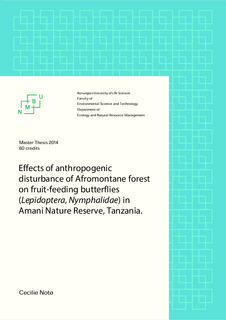| dc.description.abstract | The majority of the world’s biological diversity is located in the tropics, where forest is an essential biome. A healthy web of biodiversity is the foundation for ecosystem services humans depend on but it is currently under severe pressure due to anthropogenic disturbances. The result is a fragmented landscape of primary forest, secondary forest, plantations and agroforest. Conservation efforts have traditionally focused on preserving primary forest, but research on the response of different faunal groups to various anthropogenic disturbances has revealed incongruous results. Although still strongly disputed by some, many advocate the possible value of human-modified landscapes such as agroforest and secondary forest as alternative habitats, migration routes and buffer zones for biodiversity.
In this study, I sampled fruit-feeding butterflies (Lepidoptera, Nymphalidae) for 10 weeks in Amani Nature Reserve, Tanzania. Butterflies are frequently used as indicator species for biodiversity response to anthropogenic and environmental changes. Sampling occurred in six habitats with various degrees of anthropogenic disturbance; primary forest, moderately and heavily disturbed secondary forest, riverine forest, meadow and agroforest. 116 individuals of 19 species were collected. The effect of environmental variables and species traits on abundance, species richness and distribution was assessed. No morphological or ecological traits gave any clear trends as to the number of habitats a species was present. Canopy openness was the environmental variable most strongly correlated with abundance, with a positive relationship. Rain also significantly influenced butterfly abundance, with a negative relationship. Agroforest contained the majority of both abundance and species richness and also contained all sampled species which previously are known mainly to inhabit forests. There were no significant differences in either abundance or species richness between the closed-forest habitats in which also the species composition was similar. All though small-scale with a relatively low sample size, the findings of the present study support the view that agroforest may help maintain a high degree of biodiversity.
Heavy forest loss and poverty is closely related. Only a small fraction of the terrestrial tropical biome is within protected areas. Also, these protected areas attract human settlements due to increased employment opportunities, further increasing the pressure on the local biodiversity. With continued rates of population growth and resource exploitation, the long term viability of conservation strategies in these areas is dependent on the cooperation of local people. This emphasizes the need for further research to obtain adaptive management schemes which will maximize the conservation value of anthropogenic landscapes. | nb_NO |
